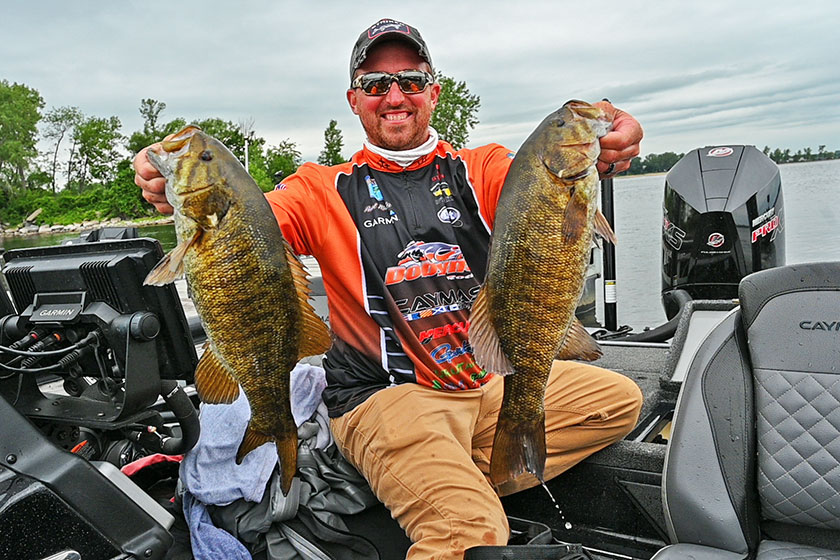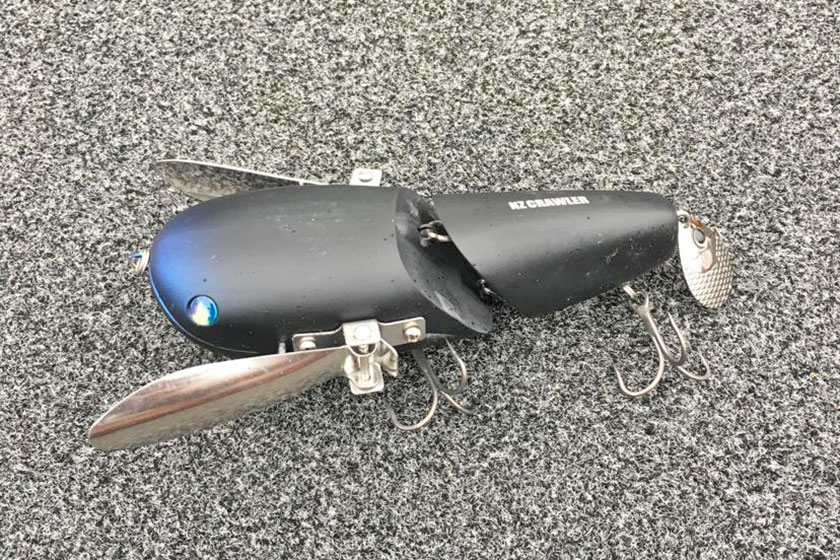
For much of the country, summer is in, or is soon to be in full swing. The spawn is mostyl over in the north and the topwater action is heating up. Grab your fishing gear and enjoy some of the best action as big bass roam the shallows waiting to explode on food that is topside.
In this 5-Part Series, Bassmaster Elite Series Pro Paul Mueller takes us through the different types of topwater baits, when and where he employs them, why he chooses one over the others, and his favorite gear for topwater success.
Plopper/Crawling Style Baits
Although plopping baits seem to be making a comeback, Mueller has been utilizing them, along with crawling style baits for years. The unique sound and action provide a nice target for bass—their curiosity gets them most of the time.
“The reason a plopping bait is so good is because they have a certain sound. Similar to a good buzz bait, it’s just a sound type of thing. Overall, plopping baits are a generic topwater bait that make it easy to cover a lot of water.”
Mueller believes it’s the most productive topwater profile anywhere in the country, anytime. All water conditions from dirty water to clean water, it catches them under a variety of situations.
“Ploppers are great for guiding because the fish just eat them—a plopper seems to catch them overall, in general, under more circumstances. Same with water clarity, it doesn’t seem to matter. They are making a comeback, but it’s still something they have not seen a whole lot of. It looks like an inline buzzbait, but looks more edible to bass, they just eat it.”
Crawling-style baits are more of a niche type of lure for Mueller. When he needs a big bass, a crawler gets the nod. With an alluring swimming motion, the wider body moves a lot of water, and a unique splashing sound is the result of the stainless-steel wings.
“These baits are not limit lures; they are big fish trophy hunting kind of presentations. They are totally different and something most fish have never seen before. Because they are not the typical style topwater lures, many anglers have not heard of it either.”
Mueller puts crawlers and large ploppers in the same category as a glide style bait. These magnum topwaters cater specifically to the largest bass in the lake.
Baits
When it comes to plopping or crawler baits, Mueller will generally throw two sizes, standard and large. The standard size baits will work on any lake around the country, and if need be, he will grab a finesse-style bait but only when fishing for much more pressured fish or on lakes where the average size bass is smaller.
For the plopping bait, a PH Customs Plopping P is his main selection. Featuring a crankbait shape body made of handcrafted balsa wood, the blade is a unique metal with a nickel finish. The metal will ensure the bait will last and allows customization by bending the blade to change the action.
“The Ploppin’ P is unique and different because it is not the main stream. It is a little more expensive compared to others, but the shape and sound is different, and they absolutely crush it. They are available in a standard 3- and 2 1/2-inch models, which are both productive lengths. I reach for the Ploppin’ on stable lake conditions and mostly around the alewife spawn up north, or some sort of shad spawn around the county.”
For the larger bait, Mueller prefers a crawler-style bait to tantalize big bass. A Deps NZ Crawler gets the nod, and it is also available in two sizes – 3 3/4- standard and 5 1/4-inch larger model. Although there is a smaller size, Mueller tends to stick with crawling baits when he is specifically fishing for big bass.
“That Deps NZ Crawler caters to big bass. The metal wings flash and it dips side to side. I use it to catch the biggest bass in the lake.”
Something that most bass have not seen, crawlers are not as mainstream and fly under the radar with most anglers. For bigger smallmouth and largemouth, Muller thinks there isn’t a better bait to tempt the curiosity of big fish and get them to commit.
“It’s a resurrected technique and popular in Japan. Heddon made one years ago and JDM made a small and larger version as well. The two aluminum wings create a tremendous swimming motion, and it moves a lot of water. The Deps NZ Crawler also has a small Colorado blade that adds additional flash.”
Gear
Rods: Dobyns Fury 733 (Open Water) Dobyns Fury 734C (Around Cover) Dobyns Sierra 735 (Large Whopper Plopper) Dobyns Fury 735C (Large Crawler)
Reel: Lew’s BB1 Pro 8.1:1
Line: 17 or 20-pound Gamma Poly Flex Copolymer
For the smaller- and standard-size plopping and crawling baits, Mueller keeps it fairly simple and slightly changes his rod depending on the cover he is fishing.
“I use the Fury 733 when I am fishing open water areas which helps make longer casts. The faster reel still allows me to get a hook in them and catch up to fish that jump. Smallmouth and largemouth alike, when they are hooked, they move fast and will jump – you must keep the slack out of the line. When I am around any sort of cover, I bump the rod up to the Fury 734 for a little more power and keep the same 17-pound Gamma Poly Flex Copolymer line.”
For the larger style baits, slightly more powerful rods and 20-pound line do the trick. Mueller uses different rods for the bigger crawler and ploppers.
“I use the big ploppers and crawlers when I am around big fish. For the larger plopper, I like the Sierra 735 as it has a bit slower action than the Champion 735 – it’s just a bit too much rod. For the crawlers, I use the same 20-pound line and like the action of the Fury 735.”



